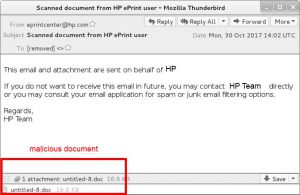 This article has been created in order to explain what is the RubyMiner malware threat and how to remove it from your computer.
This article has been created in order to explain what is the RubyMiner malware threat and how to remove it from your computer.
New cryptocurrency miner, known as RubyMiner has been detected by malware researchers. The virus aims to mine for cryptocurrencies by using the resources of your computer in order to obtain tokens. This may result in your computer to become non-responsive at times, slow down in terms of performance and in addition to this if the virus remains for longer periods of time on your computer, it may break your components due to overheating. If you believe that your computer has been infected by RubyMiner malware, recommendations are to focus on removing it preferably by reading the following article.

Threat Summary
| Name | RubyMiner |
| Type | CryptoCurrency Miner |
| Short Description | Runs a process in the background of your computer which begins to mine for anonymous cryptocurrencies. |
| Symptoms | Slow performance of your computer plus different types of system freezes and insufficient processing memory errors. |
| Distribution Method | Via fake executables or malicious web links spreading infection files. |
| Detection Tool |
See If Your System Has Been Affected by malware
Download
Malware Removal Tool
|
User Experience | Join Our Forum to Discuss RubyMiner. |

How Did RubyMiner Infect My PC?
There are more than one method by whch RubyMiner may propagate on your computer system. The virus often uses malicous files that are masked as legitimate and it may introduce them to you either passively or actively. The passive methods are if the malware uploads the malicious files on a suspicious website as the files you may be looking for to download. Such files are often:
- Fake game patches.
- Fake cracks.
- Torrent files that are actually executable files.
- Fake setups of software or games.
- Fake license activation software.
In addition to this, the cyber-criminals who are behind RubyMiner malware may also infect your computer via other methods that are more active, like sending spam messages containing short URL’s that may lead your computer to an unsafe website, causing the infection via a drive-by download or a malicious script. In addition to this, the virus may also be sent to you in the form of a fake document which only pretends to be legitimate. Such files and documents are usually accompanied by deceitful messages, like the example malicious spam e-mail below shows:

RubyMiner – Capability and Activities
When an infection with RubyMiner has taken place on your computer, the malware begins to drop it’s files on your computer. The main folders on which the files of RubyMiner may be dropped are believed to be the following:
- %AppData%
- %Local%
- %LocalLow%
- %Roaming%
- %Temp%
Once RubyMiner has set it’s files to be dropped on your PC, the virus may activate them and begin performing various malicious activities on your computer. Since it is malware, RubyMiner may extract the following information from your computer system:
- Your network information.
- Your saved passwords and logins.
- Log your keystrokes.
- Update itself.
- Copy itself multiple times to make the removal of files more difficult.
- Download other malware on your computer.
The main activity of RubyMiner however is to run a miner on your computer which begins to utilize over 90% of both your GPU and CPU (Video Card and Central Processor). These activities may result in the malware being able to generate cryptocurrency tokens and add them to the cryptocurrency wallet of the cyber-criminal who is behind the infection with RubyMiner. This usually happens by connecting your computer to a mining pool (see image below) of many computers, which easifies the mining process. The more computers, the cyber-criminal has infected and linked to his wallet, the faster he will generate cryptocurrency tokens at your PC’s expence. In addition to this, since the malware aims to stay for longer periods of time on your computer system, the virus may begin to break down your components, if it stays for longer periods of time. This is because the mining process uses a lot of the CPU and GPU’s arithmetica-logial calculating power and this results in a lot of side heat temperature to be generated in the process.

How to Detect and Remove RubyMiner from Your Computer
In order to detect this virus it is important to first check it as a process on your Task Manager and end it, because the process associated with RubyMiner needs to be closed before the malware is removed. The other scenario is if the malware runs via a malicious JavaScript, which means that your web browser security has been comptomised and you need to reinstall it. For maximum effectiveness during the removal, we advise besides doing the mentioned so far actions to also follow the removal instructions down below. Be advised that while manual removal Is reccomended for tech savvy users, security experts always outline the best method to remove malware, like RubyMiner from your computer automatically by using an advanced anti-malware software. Such may ensure that the virus stays removed from your PC in the future as well.
Preparation before removing RubyMiner.
Before starting the actual removal process, we recommend that you do the following preparation steps.
- Make sure you have these instructions always open and in front of your eyes.
- Do a backup of all of your files, even if they could be damaged. You should back up your data with a cloud backup solution and insure your files against any type of loss, even from the most severe threats.
- Be patient as this could take a while.
- Scan for Malware
- Fix Registries
- Remove Virus Files
Step 1: Scan for RubyMiner with SpyHunter Anti-Malware Tool



Step 2: Clean any registries, created by RubyMiner on your computer.
The usually targeted registries of Windows machines are the following:
- HKEY_LOCAL_MACHINE\Software\Microsoft\Windows\CurrentVersion\Run
- HKEY_CURRENT_USER\Software\Microsoft\Windows\CurrentVersion\Run
- HKEY_LOCAL_MACHINE\Software\Microsoft\Windows\CurrentVersion\RunOnce
- HKEY_CURRENT_USER\Software\Microsoft\Windows\CurrentVersion\RunOnce
You can access them by opening the Windows registry editor and deleting any values, created by RubyMiner there. This can happen by following the steps underneath:


 Tip: To find a virus-created value, you can right-click on it and click "Modify" to see which file it is set to run. If this is the virus file location, remove the value.
Tip: To find a virus-created value, you can right-click on it and click "Modify" to see which file it is set to run. If this is the virus file location, remove the value.Step 3: Find virus files created by RubyMiner on your PC.
1.For Windows 8, 8.1 and 10.
For Newer Windows Operating Systems
1: On your keyboard press + R and write explorer.exe in the Run text box and then click on the Ok button.

2: Click on your PC from the quick access bar. This is usually an icon with a monitor and its name is either “My Computer”, “My PC” or “This PC” or whatever you have named it.

3: Navigate to the search box in the top-right of your PC's screen and type “fileextension:” and after which type the file extension. If you are looking for malicious executables, an example may be "fileextension:exe". After doing that, leave a space and type the file name you believe the malware has created. Here is how it may appear if your file has been found:

N.B. We recommend to wait for the green loading bar in the navigation box to fill up in case the PC is looking for the file and hasn't found it yet.
2.For Windows XP, Vista, and 7.
For Older Windows Operating Systems
In older Windows OS's the conventional approach should be the effective one:
1: Click on the Start Menu icon (usually on your bottom-left) and then choose the Search preference.

2: After the search window appears, choose More Advanced Options from the search assistant box. Another way is by clicking on All Files and Folders.

3: After that type the name of the file you are looking for and click on the Search button. This might take some time after which results will appear. If you have found the malicious file, you may copy or open its location by right-clicking on it.
Now you should be able to discover any file on Windows as long as it is on your hard drive and is not concealed via special software.
RubyMiner FAQ
What Does RubyMiner Trojan Do?
The RubyMiner Trojan is a malicious computer program designed to disrupt, damage, or gain unauthorized access to a computer system. It can be used to steal sensitive data, gain control over a system, or launch other malicious activities.
Can Trojans Steal Passwords?
Yes, Trojans, like RubyMiner, can steal passwords. These malicious programs are designed to gain access to a user's computer, spy on victims and steal sensitive information such as banking details and passwords.
Can RubyMiner Trojan Hide Itself?
Yes, it can. A Trojan can use various techniques to mask itself, including rootkits, encryption, and obfuscation, to hide from security scanners and evade detection.
Can a Trojan be Removed by Factory Reset?
Yes, a Trojan can be removed by factory resetting your device. This is because it will restore the device to its original state, eliminating any malicious software that may have been installed. Bear in mind that there are more sophisticated Trojans that leave backdoors and reinfect even after a factory reset.
Can RubyMiner Trojan Infect WiFi?
Yes, it is possible for a Trojan to infect WiFi networks. When a user connects to the infected network, the Trojan can spread to other connected devices and can access sensitive information on the network.
Can Trojans Be Deleted?
Yes, Trojans can be deleted. This is typically done by running a powerful anti-virus or anti-malware program that is designed to detect and remove malicious files. In some cases, manual deletion of the Trojan may also be necessary.
Can Trojans Steal Files?
Yes, Trojans can steal files if they are installed on a computer. This is done by allowing the malware author or user to gain access to the computer and then steal the files stored on it.
Which Anti-Malware Can Remove Trojans?
Anti-malware programs such as SpyHunter are capable of scanning for and removing Trojans from your computer. It is important to keep your anti-malware up to date and regularly scan your system for any malicious software.
Can Trojans Infect USB?
Yes, Trojans can infect USB devices. USB Trojans typically spread through malicious files downloaded from the internet or shared via email, allowing the hacker to gain access to a user's confidential data.
About the RubyMiner Research
The content we publish on SensorsTechForum.com, this RubyMiner how-to removal guide included, is the outcome of extensive research, hard work and our team’s devotion to help you remove the specific trojan problem.
How did we conduct the research on RubyMiner?
Please note that our research is based on an independent investigation. We are in contact with independent security researchers, thanks to which we receive daily updates on the latest malware definitions, including the various types of trojans (backdoor, downloader, infostealer, ransom, etc.)
Furthermore, the research behind the RubyMiner threat is backed with VirusTotal.
To better understand the threat posed by trojans, please refer to the following articles which provide knowledgeable details.



